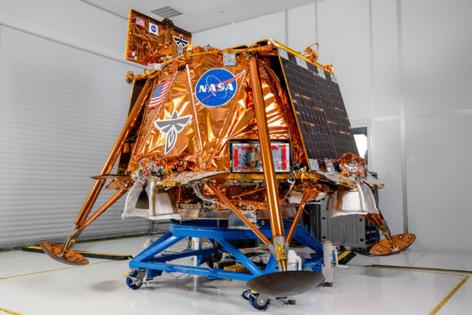Next up to the moon: Firefly's Blue Ghost lander to ship soon to Florida
Published in News & Features
ORLANDO, Fla. — Another private company will soon try its hand at sticking a landing on the moon for NASA.
Cedar Park, Texas-based Firefly Aerospace was one of several companies that won contracts under NASA’s Commercial Lunar Payload Services program, which aims to pay companies to provide a ride to the moon for its experiments.
Astrobotic Technology of Pittsburgh was the first company to launch under the program with its Peregrine lunar lander this past Janaury atop a United Launch Alliance’s Vulcan rocket. That spacecraft ultimately didn’t make it to the moon.
A month later, though, Houston-based Intuitive Machines completed the deal with a mostly successful landing of its Nova-C lander Odysseus, making it the first commercial company to ever land on the moon.
Both of those companies have more missions planned to the moon under NASA’s CLPS program, but Firefly is likely to be next up with is Blue Ghost lander, which had completed environmental testing at NASA’s Jet Propulsion Laboratory last month.
“Blue Ghost aced environmental testing and proved the lander is performing 100% as expected, which is a testament to the incredible Firefly team,” said Firefly Aerospace CEO Jason Kim in a press release. “This team has gone above and beyond with innovative testing approaches to ensure Blue Ghost is flight ready.”
It had since been moved back to the company’s Texas faciities and is prepping for shipment in mid-December to Florida where it will get processed for a launch on a SpaceX Falcon 9 rocket aiming for a six-day window as early as mid-January from Kennedy Space Center’s Launch Pad 39-A.
The company has dubbed this mission “Ghost Riders in the Sky,” the first of three task orders under CLPS so far.
It will have a 45-day trip to the moon, and aim for a landing in Mare Crisium, located on the northeast quadrant of the moon as seen from Earth. There it will operate its payloads for 14 days. It has 10 payloads lined up for NASA including experiments around lunar subsurface drilling, sample collection, lunar dust mitigation and X-ray imaging of Earth’s magnetic field.
Once the vehicle loses daylight it will measure how regolith acts during lunar dusk, and then the spacecraft will attempt to remain active several hours into the lunar night as temperatures drop.
NASA awarded Firefly $93.3 million for this initial CLPS contract in 2021.
It’s up to each commercial lunar provider to line up their own rocket ride to space and provide the mission support including communication. They can line up additional customers beyond NASA as well to help defray costs.
“While we know there will be more challenges ahead, I’m confident this team has what it takes to softly touch down on the lunar surface and nail this mission,” Kim said.
-------
©2024 Orlando Sentinel. Visit at orlandosentinel.com. Distributed by Tribune Content Agency, LLC.







Comments